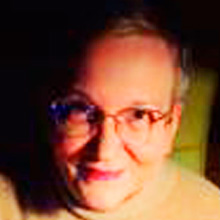En estos momentos me siento muy afortunado. Tengo el honor y el placer de tener este vis a vis con una persona muy especial, con la cual tengo varias cosas en común. Por ejemplo, es ilustradora de libros infantiles y ha publicado muchos libros, como yo, y es humorista, como yo. Además, somos contemporáneos (es tres años menor que yo, pero luce mucho más joven).
Se trata de la talentosa polaca Izabela Kowalska Wieczorek. ¿Qué puedo decir de ella?
Bueno, que nació en 1955, que estudió en la Academia de Bellas Artes de Wrocław, que hizo un Diplomado en diseño gráfico y que ha sido ilustradora de libros durante muchos años (alrededor de 40 libros para niños y 26 calendarios multiplaca, etc.). Y que desde el 2013 es una exitosa humorista gráfica. Otros datos: ha realizado exposiciones individuales y colectivas en muchísimos países. Con decirles que ¡ha ganado más de 85 premios y menciones de honor en concursos internacionales de humor gráfico!
En fin, Humor Sapiens se viste de gala hoy…
PP: Hola, Isabela. Siento que he sido muy mezquino al hablar de ti en la introducción. Por tal motivo, ¿podrías presentarte tú misma, por favor, para que te conozcan mejor los humornautas que siguen nuestro sitio web?
IZABELA: Hola, Pepe. Muchas gracias por tan buena introducción. Has dicho todo lo importante sobre mí. Me permito añadir que nací en Toruń, en una familia de artistas visuales. Desde que recuerdo, siempre me he ocupado de las ilustraciones. De niña, para disgusto de mis padres, yo "corregía" imágenes en libros para niños. Como mencionaste, en los años 1975-80 estudié pintura, gráfica y escultura en la Academia de Bellas Artes de Wrocław, donde me pronosticaron que me convertiría en ilustradora. Así que no tuve otra opción.
Poco después de defender mi Diploma, gané un concurso de diseño gráfico de cuentos de hadas y fui encasillada como ilustradora de libros infantiles. Durante más de 30 años he estado vagando por la vida con este "estigma", y cuando me cansé de pelear con los editores, decidí ponerme a prueba en el humor gráfico. Fue un éxito. He sido una feliz caricaturista satírica durante diez años.
PP: Como ilustraste libros infantiles por 30 años, sabrás a lo que me refiero cuando afirmo que el arte es un juego y el humor es un juego. Por lo tanto, la literatura infantil y la ilustración de libros para niños deben ser lúdicas y con bastante humor. Por ello me imagino que utilizaste mucho el humor en ese lindo trabajo que hiciste durante esos años, ¿no es cierto?
IZABELA: Coincido contigo en que el humor es fundamental en las ilustraciones infantiles. mis ilustraciones estaban llenos de humor, personajes divertidos y situaciones alegres que gustaban a los niños. Tuve un montón de diversión creando estas imágenes.
PP: Claro que sí, hay que divertirse uno para divertir a los demás, ¿no? Querida, viendo tu estilo de dibujo (que me encanta), no parece que haya mucha diferencia entre la ilustración que hacías y el humor gráfico que haces actualmente. Incluso diría que te diferencias bastante de la mayoría de los caricaturistas. ¿Fue sólo cambios en los contenidos y mantuviste la forma? O mejor, dinos, ¿cómo fuiste evolucionando en ese sentido?
IZABELA: Los años que pasé en el universo de los cuentos de hadas tienen un impacto en la percepción del mundo y su procesamiento. Mis ilustraciones en acrílico eran coloridas y llenas de detalles. Cuando comencé a hacer humor gráfico, tuve que cambiar a una forma más sintética -similar a un póster-, de presentar el tema, así que que el mensaje era simple y obvio. La herramienta principal se convirtió en un fineliner, que en gran medida aceleró la ejecución del dibujo.
Lo que tienen en común mis ilustraciones y el humor gráfico que realizo es el uso deliberado de préstamos del mundo de los cuentos de hadas, que suavizan el mensaje y a menudo despiertan el interés de los los más jóvenes, por lo que el grupo de nuevos destinatarios va en aumento.
PP: Te dije ya que soy tu mayor admirador en ese sentido. ¡Me encantan tus dibujos tan “infantiles”, expresando ideas de asdultos, mensajes profundos, en forma de sátira. Pero confiésanos, ¿cuál de las dos manifestaciones es tu favorita, la ilustración infantil o el humor gráfico?
IZABELA: El humor gráfico, porque me dio libertad de expresión y sentido de independencia.
PP: Me gusta mucho esa última frase… ¿Sabes, Izabela? Cuando más arriba mencionaste la palabra “afiche”, estuve recordando que en los años 60 y 70 me impresionaba la calidad de los afiches de cine polacos. ¿Crees que el arte gráfico y visual en general polaco ha influenciado en tu obra? ¿Piensas que has tenido influencias de algún artista visual polaco en particular?
IZABELA: El arte polaco ciertamente tuvo cierta influencia en mí. Mis padres, sus amigos y mi hermano vivían el arte. Mis profesores en la academia eran famosos cartelistas. Sin embargo, yo no recuerdo que algún artista polaco, aparte de mi ilustrador favorito de la infancia: Jan Marcin Szancer y una gran pintora: Olga Boznańska, me hayan influenciado. No me gustaba seguir las tendencias.
PP: ¿Cuáles son los humoristas gráficos vivos o muertos que más te gustan?
IZABELA: No mencionaré a los vivos, porque hay demasiados artistas alrededor del mundo que valoro y admiro.
De los que abandonaron el reino terrenal, Charles Addams con "La familia Addams" y Jean Effel con su "Creación del mundo", tuvieron la mayor influencia en mis elecciones posteriores. Junto a los cuentos de hada para niños, esos eran mis libros favoritos de la infancia. Durante mis estudios, me encantaron los dibujos satíricos de Otto Anton Reisinger y Adolf Born.
Gracias a estos cuatro grandes creadores del humor gráfico que señalo, ahora soy dibujante.
PP: Perfecto. Pero ahora me gustaría que nos contaras algo más personal. ¿Te sientes feliz y realizada con tantísimos premios que has obtenido en tu carrera? ¿Te propusiste alguna vez ser tan triunfadora? ¿Te han sorprendido los éxitos en tu carrera?
IZABELA: Soy feliz y realizada, porque hago lo que mas me gusta, tengo muchos amigos online y colegas caricaturistas, con quienes realizo un "diálogo pictórico".
Los premios y menciones honoríficas son la guinda del pastel y el mejor estímulo para una mayor participación en concursos de dibujos satíricos. Los premios siempre me sorprenden y me hacen muy feliz, porque me aseguran que los cambios que hice en mi vida fueron los correctos.
PP: ¡Correctísimos!! ¡Y me imagino que has estado muy feliz últimamente, porque no paran tus premios! Te felicito. Pero sigamos en lo nuestro. Por ejemplo, me gustaría saber algo: entre los recursos del humor que hacen reír y pensar, ¿cuál prefieres utilizar más en tus obras: el humor blanco, el humor negro, la sátira, la ironía, la crítica ácida?
IZABELA: Todo depende del tema que esté abordando. Principalmente uso en mis trabajos la sátira y la ironía.
PP: ¿Podrías contar una anécdota ya sea graciosa, o ingeniosa, o curiosa, que hayas vivido dentro de tu carrera en el humor?
IZABELA: Hace diez años participé de forma experimental en mi primer concurso satírico. Estaba esperando que una de mis obras fuera aceptada para una exposición, cuando me llamó un vecino felicitándome por mi premio, del que había oído hablar en la radio.
Parecía tan increíble esa noticia que me decía, que en lugar de agradecerle, le respondí que no era cierto, que había oído mal. Esa persona se ofendió conmigo.
Para mi gran sorpresa, la noticia no tardó en confirmarse, obtuve el Gran Premio y tuve que disculparme con mi vecino.
PP: Te entiendo. A uno le cuesta asimilar que ha ganado algo. Querida amiga, ahora teoricemos un poco. Como sé que algunos lo dudan, te pregunto: ¿el humor es un arte? Me refiero sobre todo a su supuesta característica de “parásito”, ya que sólo aparece dentro de un arte (gráfico, musical, escénico, etcétera).
IZABELA: El humor es un arte que puede existir independientemente, como el humor gráfico, el humor fotográfico etc.
Cuando el humor es un componente de un todo mayor, no "parasita" sino, por el contrario, lo enriquece enormemente. Qué sería del cine, la literatura o el teatro clásico, sin episodios humorísticos. Grandes obras sin lo grotesco no resistirían la prueba del tiempo.
PP: Sabemos que el trabajo ideal del humor gráfico es el que muestra una factura perfecta y un contenido que nos hace sonreír y pensar. Pero a menudo vemos una magnífica idea expresada con una factura pobre y viceversa o un trabajo impecable en términos de forma, pero con una idea débil. ¿Cuál de estas dos variantes aceptas mejor? ¿O ninguna o ellas? ¿Por qué?
IZABELA: El humor gráfico se basa principalmente en una idea. Desafortunadamente, la mejor idea cuando es pobre la ejecución, puede pasar desapercibida, y ciertamente, no será debidamente apreciada.
PP: Coincido contigo. Cuando veo una buena idea mal realizada, me duele el corazón. Bueno, pero ese no es tu caso. Porduces obras de gran contido y de excelentísima forma. Por esa razón has participado (y participas) en muchísimo concursos internacionales de humor gráfico, y por esa razón has obtenido tantos premios. Eso me da pie para preguntarte: ¿ves mucha diferencia entre el humor creado para los concursos y el resto? Es que a veces muchos dibujantes no le ponen el suficiente empeño en la calidad del dibujo en sus obras “cotidianas”. ¿Ves eso correcto?
IZABELA: Veo que la mayoría de mis compañeros dibujantes tienen un enfoque muy honesto del tema, ya sea sobre participar en concursos o con obras publicados en Internet.
Dibujos satíricos sobre eventos actuales, donde cada momento cuenta. Por ejemplo, el estallido de la guerra, una catástrofe, u otros eventos, que requieren una rápida difusión de la información, requieren entonces mayores simplificaciones. Pero los maestros de la línea no tienen problema con eso. No funciona para todos, pero las buenas intenciones cuentan.
PP: Es cierto. Bueno, y también con tu experiencia como Jurado en muchísimos concursos, ¿cómo ves la situación actual del humor gráfico en el mundo? Específicamente, ¿hay suficientes espacios para publicar? ¿Internet es la solución? ¿Hay suficiente público consumidor?
IZABELA: Gracias a Internet, a pesar de condiciones desfavorables, como pandemias, estados de emergencia y guerras, las competiciones continúan y hay aún más. Se mueven del mundo real al virtual, en beneficio de los participantes, que tienen un acceso más confiable para ellos y teienen menos estrés asociado con el envío de los originales. El humor gráfico que se publica en Internet, a menos que las obras sean atrapadas por el ojo vigilante de la censura, también lo están haciendo muy bien y se está difundiendo salvajemente.
Algo peor es la situación de los artistas que no tienen influencia en el destino de sus obras que flotan por ahí en el mundo virtual, a menudo con creaciones anónimas.
Por otro lado, los caricaturistas se hacen más famosos, porque al subir sus obras a Internet participan de una interminable exhibición. Lamentablemente, no sé nada sobre el público consumidor.
PP: Por lo que sé, hay algunos que afirman que con los memes, la gente se ha acercado. Más al humor gráfico. Sin embargo, otros aseguran lo contrario, porque esgrimen que los memes y su “facilidad” de ejecusión, amenaza el buen humor gráfico. Hay que seguir estudiando el punto. Bueno, mencionaste la censura en Internet. Te pregunto entonces, ¿tenemos mucha censura en los medios y en la sociedad en general en estos tiempos? ¿Mucha autocensura?
IZABELA: La censura en los medios depende de la política y la cultura del país en el que operan estos medios. En países extremadamente autoritarios, caricaturistas o periodistas inconvenientes son aniquilados. En los países democráticos está más vigente la autocensura, basada en la moral código de cada creador. En Internet, por ejemplo, en Facebook, la censura funciona demasiado automáticamente.
Los sitios web que utilizan símbolos políticamente incorrectos se eliminan, independientemente del contexto de su uso.
PP: Sin contar el aumento de la censaura de lo políticamente correcto. En fin, para usar la pregunta de moda: ¿cuáles son los límites del humor para ti?
IZABELA: Los límites del humor dependen de muchos factores relacionados con el lugar donde vivimos.
El humor está limitado por la censura, el miedo a la desaprobación o la exposición a la opresión, y el autoengaño. Censura, que, si se viola, resulta en la incapacidad de mirarse en el espejo.
Desafortunadamente, en tales condiciones, la sátira política no puede desempeñar su papel principal, es decir, a través de la crítica. Y ridiculizar, puede defender el estado de derecho y estigmatizar los abusos de poder.
PP: Cambiemos de tema. ¿Qué le dirías a las personas que se inician en este mundo del humor gráfico? ¿Y qué le dirías a tus colegas?
IZABELA: ¡Bienvenido al maravilloso mundo del humor gráfico! Si eres trabajador, y tienes la intención de dedicarte por completo a este campo del arte y no te importa el dinero, has venido al lugar correcto. Aquí encontrarás satisfacción y plenitud, y con un poco de suerte tendrás éxito.
A mis colegas: les deseo infinita inspiración creativa, muchos años más de salud, competencia en concursos de humor gráfico y muchas victorias.
PP: Dentro del humor, ¿qué te gustaría hacer que no hayas hecho (incluso puede ser hasta incursionar en otras modalidades).
IZABELA: Me gustaría publicar algún día un álbum de mis dibujos satíricos.
PP: No tengo la menor dudas que en más de una oportunidad vas a cumplir esos deseos. Bueno, para ir terminando este vis a vis, ¿hay alguna pregunta que no te haya hecho y que te hubiera gustado que te hiciera? Si es así, ¿puedes responderla ahora?
IZABELA: Hiciste muchas preguntas importantes por las que te agradezco. No tengo nada que añadir.
PP: Mil gracias. Y por último, para no molestarte más, ¿podrías dedicarle unas palabras a nuestros seguidores de humorsapiens.com?
IZABELA: Saludo cordialmente a todos los seguidores de Humor Sapiens y gracias por ser fieles lectores de este Boletín único, gracias al cual su popularidad es tan grande.
Estimado Pepe, gracias por invitarme a esta interesante conversación. Te deseo que el entusiasmo nunca te abandone y que contagies a todos con tu energía, humor y amor por este arte.
PP: Te doy millones de gracias, querida Izabela, por haber compartido tan generosamente tu tiempo y por haber tenido tanta paciencia para soportar mis preguntas.
Te deseo lo mejor del mundo; es decir, mucha salud, mucha lucidez, mucha suerte y muchos éxitos. ¡Un abrazo!
(Este texto ha sido traducido al español por Google Translate)
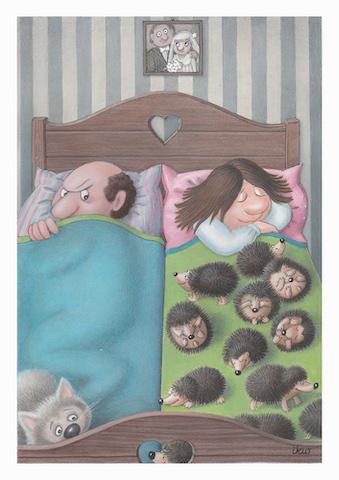
Best friends
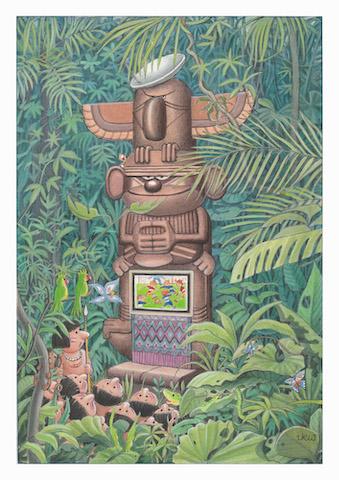
New tradition
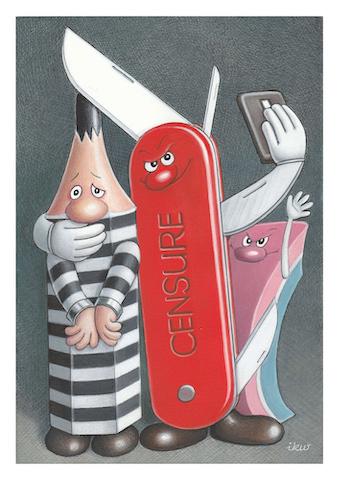
Friendly censure
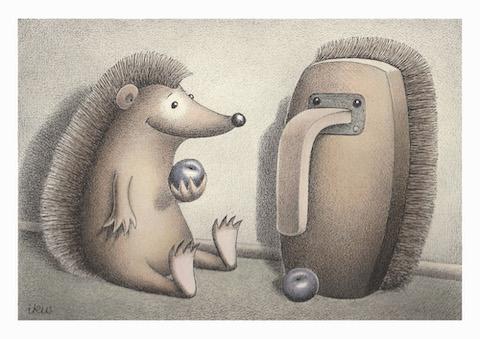
Almost twins

Camouflage
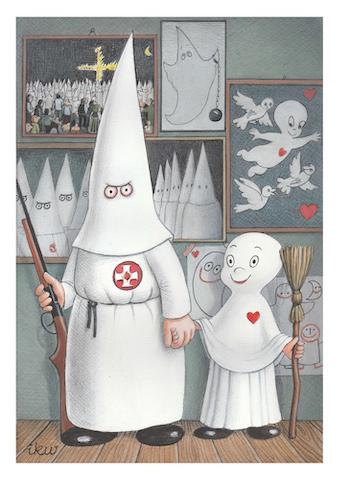
Dad and son
Interview with Izabela Kowalska Wieczorek
By Pepe Pelayo
Graphic humor gave me freedom of expression and a sense of independence
Right now I feel very lucky. I have the honor and pleasure of talking with a very special person, with whom I have several things in common. For example, she is an illustrator of children's books and has published many books, like me, and she is a humorist, like me. Also, we are contemporaries (she is three years younger than me, but looks much younger).
This is the talented Polish Izabela Kowalska Wieczorek.
What can I say about her?
Well, that she was born in 1955, that she studied at the Wrocław Academy of Fine Arts, that she did a Diploma in graphic design and that she has been an illustrator of books for many years (about 40 children's books and 26 multi-plate). calendars, etc.). And that since 2013 he has been a graphic humorist.
Other information: he has had individual and collective exhibitions in numerous countries. Telling them that he has won more than 85 awards and honorable mentions in international graphic humor contests!
Anyway, Humor Sapiens dresses up today...
PELAYO: Hello, Isabella. I feel like I've been too mean when talking about you in the introduction. For this reason, could you introduce yourself, please, so that the humornauts who follow our website get to know you better?
IZABELA: Hello, Pepe. Thank you very much for such a nice introduction.
You've said everything important about me. May I just add that I was born in Toruń, in a family of visual artists. For as long as I can remember, I've always dealt with illustrations. As a child, to the annoyance of my parents, I "corrected" pictures in children's books.
In the years 1975-80 I studied painting, graphics and sculpture at the Academy of Fine Arts in Wrocław, where I was predicted that I would become an illustrator. So I had no other choice.
Shortly after defending my diploma, I won a competition for the graphic design of fairy tales and was pigeonholed as an illustrator of children's books. For over 30 years I've been wandering through life with this "stigma", and when I had enough of fighting with publishers, I decided to test myself in graphic humor. It was a hit. I have been a happy satirical cartoonist for ten years.
PELAYO: As you have illustrated children's books for 30 years, you will know what I mean when I say that art is play and humor is play. Therefore, children's literature and children's book illustration should be playful and with plenty of humor. That is why I imagine that you used humor a lot in that beautiful work that you did during those years, right?
IZABELA: I agree with you that humor is essential in children's illustrations. My illustrations were full of humor, funny characters and cheerful situations that children liked. I had a lot of fun creating these pictures.
PELAYO: Of course, you have to have fun to entertain others, right? My dear, looking at your drawing style (which I love), there doesn't seem to be much difference between the illustration you did and the graphic humor you do today. I would even say that you are quite different from most cartoonists. Was it just changes in the contents and did you keep the form?Or better, tell us, how did you evolve in that sense?
IZABELA: The years spent in the world of fairy tales have an impact on the perception of the world and its processing. My acrylic iIllustrations were colorful and full of detail. When I took up graphic humor, I had to switch to a more synthetic, poster-like way of presenting the subject, so
that the message was simple and obvious. The main tool became a fineliner, which greatly accelerated the execution of the drawing.
What the illustrations and graphic humor have in common is the deliberate use of borrowings from the world of fairy tales, which soften the message and often arouse the interest of the youngest, so the group of new recipients is growing.
PELAYO: I already told you that I'm your biggest fan in that sense. I love your "childish" drawings, expressing adult ideas, deep messages, in the form of satire. But tell us, which of the two manifestations is your favorite, children's illustration or graphic humor?
IZABELA: Graphic humor, because it gave me freedom of expression and a sense of independence.
PELAYO: I like that last sentence. I will use it as the title of this dialogue… Do you know, Izabela? When you mentioned the word "poster" above, I remembered that in the 60's and 70's I was impressed by the quality of Polish movie posters. Do you think Polish graphic and visual art in general has influenced your work? Do you think you have been influenced by any Polish visual artist in particular?
IZABELA: Polish art certainly had some influence on me. My parents, their friends and my brother lived art, my professors at the academy were famous poster artists. However, I do not remember that any Polish artist, apart from my favorite childhood illustrator - Jan Marcin Szancer and a great painter - Olga Boznańska inspired me. I didn't like following trends.
PELAYO: Which are the live or dead graphic humorists that you like the most? Which cartoonists dead or alive do you like the most?
IZABELA: I will not mention the living ones, because there are too many artists around the world whom I value and admire.
Of those who left the earthly realm, Charles Addams with "The Addams Family" and Jean Effel with his "Creation of the World" had the greatest influence on my later choices. Next to fairy tales for children, these were my childhood favorite books.
During my studies, I was enchanted by the satirical drawings of Otto Anton Reisinger and Adolf Born.
Thanks to these four great creators of graphic humor, I am now a cartoonist.
PELAYO: Perfect. But now I would like you to tell us something more personal. Do you feel happy and fulfilled with so many awards that you have obtained in your career? Have you ever set out to be so successful? Have you been surprised by the successes in your career?
IZABELA: I am happy and fulfilled because I do what I like the most, I have many online friends and colleagues - cartoonists, with whom I conduct a "pictorial dialogue".
Awards and honorable mentions are the icing on the cake and the best encouragement for further participation in satirical drawing competitions. Prizes always surprise me and make me very happy, because they reassure me that the changes I made in my life were the right ones.
PELAYO: Very correct!! And I imagine that you have been very happy lately, because your prizes do not stop! Congratulations. But let's get on with it. For example, I would like to know something: among the humor resources that make you laugh and think, which do you prefer to use more in your works: white humor, black humor, satire, irony, acid criticism?
IZABELA: It all depends on the topic you are taking up. I mostly use in my works satire and irony.
PELAYO: Could you tell an anecdote, either funny, or witty, or curious, that you have experienced during your career in humor?
IZABELA: Ten years ago, I experimentally took part in my first satirical contest, Tuba Satirica, hoping that one of my works would be accepted for an exhibition. One day a neighbor called me congratulating me on my award she had heard about on the radio. It seemed so incredible to me that instead of thanking I said it wasn't true, and she had misheared. She took offense at me. To my great surprise, the news was soon confirmed, I got the Grand Prix and had to apologize to my neighbor.
PELAYO: I understand you. It is difficult for one to assimilate that they have won something. Dear friend, now let's theorize a little. As I know that some doubt it, I ask you: is humor an art? I am referring above all to its supposed characteristic of "parasite", since it only appears within an art (graphic, musical, scenic, etc.).
IZABELA: Humor is an art that can exist independently as graphic humor, photographic humor or humoresque, etc. when humor is a component of a larger whole, it does not "parasitize" but, on the contrary, immeasurably enriches it.
What would classical cinema, literature or theater be without humorous episodes. Great works without the grotesque would not stand the test of time.
PELAYO: We know that the ideal work of graphic humor is the one that shows a perfect invoice and content that makes us smile and think. But often we see a magnificent idea expressed with a poor execution and vice versa or an impeccable work in terms of form, but with a weak idea. Which of these two variants do you accept better? Or none or them? Because?
IZABELA: Graphic humor is mostly based on an idea. Unfortunately, the best idea with poor execution can go unnoticed, and certainly will not be properly appreciated.
PELAYO: I agree with you. When I see a good idea badly done, my heart aches. Well, but that's not your case. You produce works of great content and excellent form. For that reason you have participated (and still do) in many international graphic humor contests, and for that reason you have won so many awards. That leads me to ask you: do you see much difference between the humor created for the contests and the rest? It is that sometimes many cartoonists do not put enough effort into the quality of the drawing in their "everyday" works. Do you see that right?
IZABELA: I see most of my fellow cartoonists have a very honest approach to the subject, whether it's about participating in competitions or humorous graphics posted on the Internet.
Satirical drawings about current events, where every moment counts, e.g. the outbreak of war, a catastrophe or others, requiring quick dissemination of information, require greater simplifications, but the masters of the line have no problem with that. It doesn't work out for everyone, but good intentions count.
PELAYO: It's true. Well, and also with your experience as a Jury in many contests, how do you see the current situation of graphic humor in the world? Specifically, are there enough spaces to post? Internet is the solution? Is there enough consumer public?
IZABELA: Thanks to the Internet, despite unfavorable conditions, such as pandemics, states of emergency and wars, competitions continue and there are even more of them. They move from the real world to the virtual one, to the benefit of the participants, who have more reliable access to them and less stress associated with sending the originals. Internet graphic humor, unless it gets caught by the watchful eye of censorship, is also doing great and spreading wildly. Slightly worse is the situation of artists who have no influence on the fate of their works floating around
in the virtual world, often as anonymous creations. On the other hand, cartoonists are more famous, because by uploading their works to the Internet, they participate in a never-ending exhibition. Unfortunately I don't know anything about consumer public.
PELAYO: From what I know, there are some who claim that with memes, people have gotten closer. More to graphic humor. However, others who assert the opposite, because they argue that memes and their "ease" of execution threaten good graphic humor. You have to continue studying the point. Well, you mentioned internet censorship. I ask you then, do we have a lot of censorship in the media and in society in general these days? Lots of self-censorship?
IZABELA: Censorship in the media depends on the politics and culture of the country in which these media operate. In extremely authoritarian countries, inconvenient cartoonists or journalists are annihilated. In democratic countries, self-censorship is more in force, based on the moral code of each creator. On the Internet, e.g. on Facebook, censorship works too automatically.
Websites that use politically incorrect symbols are removed, regardless of the context of their use.
PELAYO: Not counting the increase in censorship of what is politically correct. Anyway, to use the fashionable question: what are the limits of humor for you?
IZABELA: The limits of humor depend on many factors related to the place where we live.
Humor is limited by censorship, fear of disapproval or exposure to oppression, and self-censorship, which, if violated, results in the inability to look at yourself in the mirror.
Unfortunately, in such conditions, political satire cannot play its main role, i.e. through criticism and ridicule, it can uphold the rule of law and stigmatize abuses of power.
PELAYO: Let's change the subject. What would you say to people who are new to this world of graphic humor? And what would you tell your colleagues?
IZABELA: Welcome to the wonderful world of graphic humour! If you are hardworking, you intend to devote yourself completely to this field of art and you do not care about money, you have come to the right place. Here you will find satisfaction and fulfillment, and with a bit of luck you will succeed.
To my colleagues: I wish you endless creative inspiration, many more years of healthy competition in cartoon contests and many victories.
PELAYO: Within humor, what would you like to do that you haven't done (it can even be to dabble in other modalities).
IZABELA: I would like to publish an album of my satirical drawings someday.
PELAYO: I have no doubt that with more than a good opportunity you will fulfill those wishes. Well, to finish this dialogue, is there any question that I have not asked you and that you would have liked me to ask you? If so, can you answer it now?
IZABELA: You asked a lot of important questions for which I thank you. I have nothing to add.
PELAYO: Thank you. And finally, so as not to bother you anymore, could you dedicate a few words to our followers of humorsapiens.com?
IZABELA: I cordially greet all followers of Humor Sapiens and thank you for being faithful readers of this unique bulletin, thanks to which its popularity is so huge.
Dear Pepe, thank you for inviting me to this interesting conversation. I wish you that your enthusiasm never leaves you and that you infect everyone with your energy, humor and love of art.
PELAYO: I give you a million thanks, dear Izabela, for having shared your time so generously and for having been so patient to put up with my questions.
I wish you the best of the world; that is, a lot of health, a lot of lucidity, a lot of luck and a lot of success. A hug!

